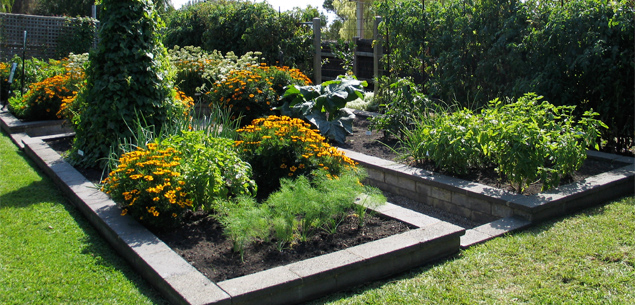It’s that time of year when those of us who planted our vegetable gardens a month or two ago start feeling particularly smug. Fresh salads crafted from rocket, mizuna and cos, scattered with four different kinds of parsley and desperately trendy mint basil, are gracing our tables every day.
We’re eating sandwiches of homemade bread filled with heritage tomatoes, organic microgreens and free-range eggs, and we’re all incredibly healthy in both the physical and financial sense.
We’re also much more focused on growing our own food. What frightens me is that the newly converted may dig up their professionally designed, stylish gardens and convert them to messy vege patches bordered by mounds of strong-smelling organic matter, pretending it’s going to be fabulous compost one day.
Because you don’t have to sacrifice style to grow great food. You really can have it all. If you’re a newbie when it comes to food production, here are my top tips:
Designate an area for food, making compost and keeping hens, if that’s your fancy. Define it with trellis, trees or some other form of camouflage.
Don’t think you can get around it by growing food in elegant terracotta urns in your courtyard – unless you’re happy with two lettuces a month and a pot of leggy basil. A collection of slug-infested greens will not look good on the deck. Better to develop a decent-sized raised bed (or two, or three), fill it with quality soil and plant enough to feed the masses.
Be realistic about what you can achieve in the time you have. Edible gardening can be a full-time job if you want it to be, so keep expectations in check.
Decide what you and your family want to eat, then get information from a reputable source on how to grow it. I’ve been given some astonishing gardening tips in my time, some of which have been useful and some of which have been complete rubbish. The internet is also guilty of perpetuating many a myth and some gardening websites are no place for the uninitiated. Choose reputable sites with advice and contributions from people whose names you recognise, or who run nurseries you’ve heard of. Buy books by well-known authors. And don’t believe everything you see on TV.
If improving your bank balance is part of your agenda, work out whether it’s going to be cheaper to grow than buy your produce. Onions and potatoes are usually reasonably priced, so you might be better to put your efforts into growing the veges that are most expensive in the shops. A price upwards of $2 for a capsicum, for example, might be enough to send you racing to the seedling table at your local farmers’ market. Garlic is another case in point – it’s never cheap, but it’s reasonably easy to grow provided you plant at the right time and feed it.
If space is at a premium, purchase pots. Get one for mint (which is one of the few things best grown in a pot, as without such confinement it’ll take over) and perhaps another for an ornamental dwarf citrus. A garden seat adds a bit of style too – you’ll never have time to sit in it, but it’s somewhere to put your trowel and straw hat.
A fine balance
Going hand in hand with the new devotion to growing food is the desire to be sustainable. But I was stumped as to how to define it when asked what it really meant. Shamefaced, I consulted my dictionary, which said: “able to be maintained at a certain rate or level, and conserving an ecological balance by avoiding depletion of natural resources”.
A slightly more useful explanation, on a gardening website, was “using materials whose production doesn’t destroy natural habitat or cause pollution during their transportation or end use, along with recycling materials that are already on site”.
I like the part about recycling, although I must admit I’m not totally driven by environmental altruism – it’s equally about making sure my bank account remains sustainable too. So I’d far rather build a stone wall, despite the labour, from rocks found on the property, than cart in a trailer load of expensive blocks.
Cutting down on the use of concrete and cement was one of the sustainability guidelines I found on a website the other day. It counselled gardeners to replace cemented walls with dry-stone, rammed earth, turf banks or gabions filled with recycled materials, and recommended the use of products that don’t need cement footings.
Replacing gravel with bark, shells or recycled glass was another suggestion. I can’t imagine re-surfacing the driveway with glass, but I love shell paths, and they look great around vegetable beds.
You can also reuse materials found around your property or suburb. Old paving can be broken up and used for drainage, and the turf you dig out to make a vege garden can be used to patch up other areas where the grass has died off. Design your garden to minimise new construction. If you do need construction work done, try to find contractors who will work within sustainable criteria.
Finally, your garden is likely to be more sustainable if you choose plants grown locally. Such plants often do better than those that have been brought in from miles away.




